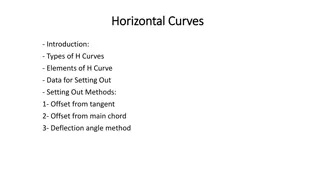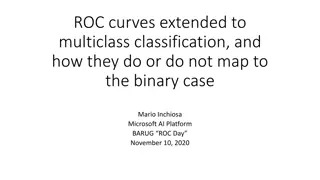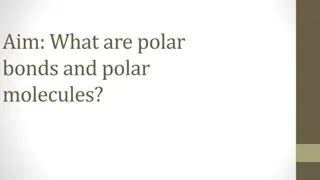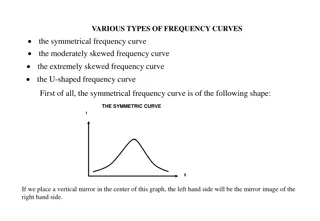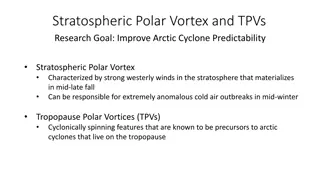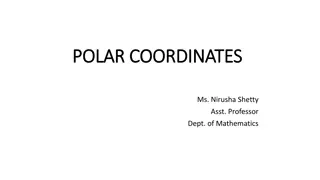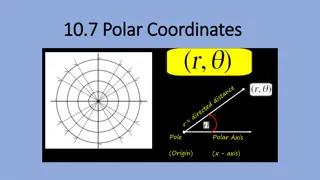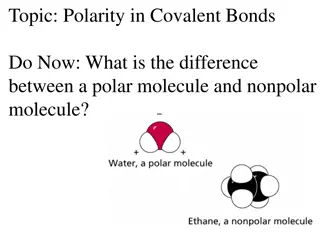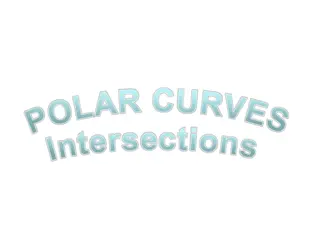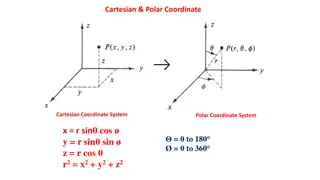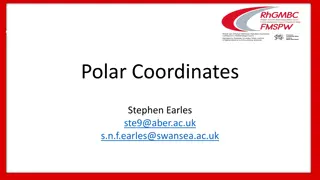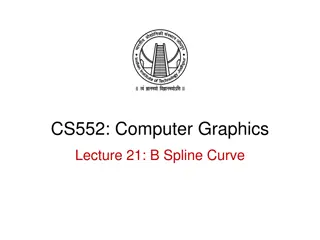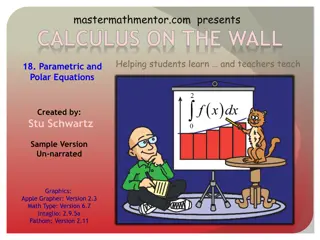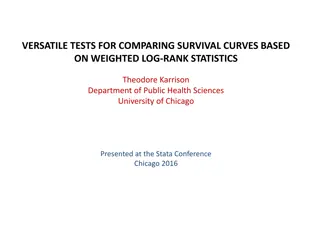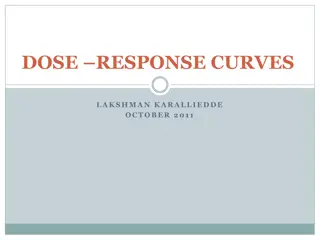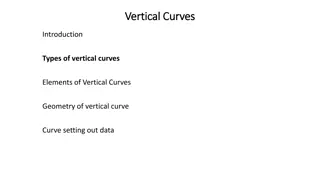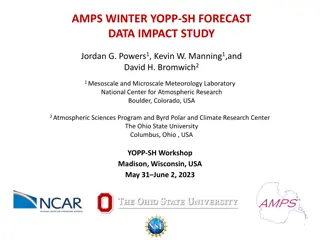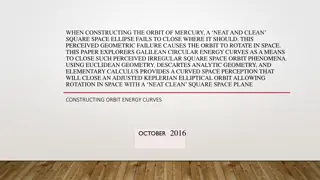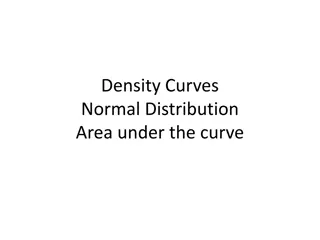Horizontal Curves in Road Design
Horizontal curves are essential in road design to safely change alignment or slope. This article covers types of horizontal curves, setting out methods, geometric shapes of curves, and elements such as PI point, PC point, and radius. Learn why curves are crucial for modern highways and how different
0 views • 25 slides
ROC Curves in Multiclass Classification
ROC curves are extended to multiclass classification to evaluate the performance of models in scenarios such as binary, multiclass, and multilabel classifications. Different metrics such as True Positive Rate (TPR), False Positive Rate (FPR), macro, weighted, and micro averages are used to analyze t
3 views • 8 slides
Geometric Design of Highway Vertical Curves and Criteria
This content covers the vertical alignment in transportation engineering, focusing on the geometric design of highway facilities, specifically vertical curves like crest and sag curves. It explains the main design criteria for vertical curves, including minimum stopping sight distance provision, dra
2 views • 24 slides
Petroleum Fraction Distillation Curves
Characterization and properties of petroleum fractions are essential for understanding their behavior, particularly through distillation curves. These curves depict the boiling points of crude oil or petroleum fractions, highlighting components' volatility ranges. Various methods like ASTM D86, True
1 views • 28 slides
Indifference Curve, Budget Line, and Consumer Equilibrium
Indifference curves and budget lines are essential concepts in economics to analyze consumer behavior and preferences. Dr. Pooja Singh, an Assistant Professor at Chhatrapati Shahu Ji Maharaj University, Kanpur, explains how indifference curves represent different combinations of goods that offer the
1 views • 9 slides
Polar Bonds and Molecules in Chemistry
Learn about polar and nonpolar covalent bonds, the classification of bonds based on electronegativity differences, and how to identify polar molecules through unequal sharing of electrons. Practice determining bond types and grasp the concept of partial charges in polar bonds.
0 views • 18 slides
Quantitative Aspects of Drug Action
Explore the quantitative aspects of drug action, including drug receptor binding, concentration binding curves, dose-response curves, and types of antagonism. Learn to relate drug concentration to receptor binding capacity and response produced. Discover how concentration binding curves and dose-res
0 views • 29 slides
Various Types of Frequency Curves in Statistics
Explore different types of frequency curves such as symmetrical, moderately skewed, extremely skewed, and U-shaped curves. Symmetrical curves exhibit mirror images on either side, while skewed curves have longer tails on one side. Extreme skewness results in J-shaped or reverse J-shaped curves. The
1 views • 8 slides
Soft Gamma-Ray Emissions from Pulsar Polar Caps
Soft gamma-ray emissions from the polar cap cascade region are a subject of interest in astrophysics, with studies focusing on the fundamental physical processes of pulsars and potential origins of non-thermal X-ray emissions. Researchers explore the emission processes, polar cap accelerators, casca
0 views • 16 slides
Arctic Habitat and Polar Bears: A Conservation Perspective
The Arctic habitat, home to diverse plants and animals like polar bears, faces threats such as climate change, toxic pollution, and oil exploration. Despite past population growth, polar bear numbers are now estimated to be between 22,000 to 31,000. Conservation efforts by Scandinavian countries hav
3 views • 6 slides
Conservation and Climate Change: Impact on Polar Bears
Learn about the real conditions and future possibilities of climate change on the Arctic, focusing on polar bears and their habitat. Understand how human actions, such as controlling pollution, can make a difference in protecting endangered species like polar bears from extinction due to the melting
1 views • 11 slides
Robust Parity Test for Extracting Parallel Vectors in 3D
Fundamental primitives for visualizing 3D data include line features like ridges and valleys of a scalar field, stream lines of a vector field, vortices of a velocity field, and extremal curves of a tensor field. Parallel Vectors (PV) provide a unified representation of 3D line features, forming con
0 views • 27 slides
Automated Tool for Inventorying and Characterizing Horizontal Curvature in Roadways
Improving highway safety is a priority for transportation departments. This project aims to develop a tool that automates the identification and characterization of horizontal curves in roadway networks using GIS technology. Roadway curvature, including horizontal curves, plays a key role in predict
1 views • 26 slides
Supply and Demand in a Competitive Market
This content delves into the concept of supply and demand in a competitive market as described by the renowned economists Paul Krugman and Robin Wells. It covers the basics of a competitive market, the dynamics of supply and demand curves, movements along curves, market equilibrium, and how prices a
1 views • 42 slides
Graphing Polar Equations: Examples and Symmetry Tests
Explore examples of graphing polar equations like r = 3, r = 4sin(θ), and more. Learn how to identify and graph such equations, along with tests for symmetry in polar graphs. Understand the relationship between polar axis, lines, and the pole in polar coordinate systems.
2 views • 15 slides
Research on Stratospheric Polar Vortex and TPVs for Arctic Cyclone Predictability
This research aims to enhance predictability of Arctic cyclones by studying the Stratospheric Polar Vortex and Tropopause Polar Vortices (TPVs). The presence of strong westerly winds in the stratosphere during fall leads to anomalous cold air outbreaks in mid-winter. TPVs serve as precursors to arct
0 views • 4 slides
Polar Coordinates in Mathematics
Polar coordinates define the location of a point in terms of distance and angle from an origin. The distance is denoted by "r" and the angle by "?". However, the angle is not unique for a point. The concept involves fixing an origin and an initial ray, with positive angles measured counterclockwise.
1 views • 7 slides
Polar Coordinates in Mathematics
Polar coordinates provide an alternative way to plot points using a directed angle and distance from the origin. This system involves radius (distance) and angle measurements, allowing for multiple representations of points. Graphing polar coordinates, converting between polar and rectangular coordi
0 views • 19 slides
Polarity in Covalent Bonds
The difference between a polar molecule and a nonpolar molecule lies in the distribution of electrons. A polar molecule has an asymmetric electron distribution due to a significant difference in electronegativity, while a nonpolar molecule has a symmetric electron distribution. You can predict polar
0 views • 15 slides
Polar Curves: Intersections, Areas, and Calculating Enclosed Areas
Explore polar curves, their intersections, areas enclosed by curves, and calculating enclosed areas using given equations. Learn to sketch graphs, find points of intersection, polar coordinates, and apply formulas for finding enclosed areas with examples provided.
0 views • 21 slides
Cartesian and Polar Coordinate Systems
Explore the concepts of Cartesian and Polar coordinate systems, including their formulas and visual representations. Dive into the relationships between Cartesian and Polar coordinates, as well as their applications in mathematics and physics. Discover orbital shapes such as Px, Py, Pz, and dz2 orbi
2 views • 12 slides
Setting Up Polar Heart Rate Monitors for School Fitness Tracking
In Sun West schools, every classroom is equipped with Polar heart rate monitors for tracking student activity. By setting up Polar Beat, Flow, and Coach accounts, teachers can remotely monitor and analyze student workouts. This guide covers creating Polar Flow and Coach accounts, syncing student acc
0 views • 10 slides
Polar Plots in System Analysis
The polar plot of a sinusoidal transfer function G(jω) represents the magnitude and phase angle of G(jω) on polar coordinates as ω varies from zero to infinity. It provides valuable insights into the frequency response characteristics of a system in a single plot. By following specific steps, you
1 views • 56 slides
Introduction to Polar Coordinates: A Different Coordinate System
Exploring the concept of polar coordinates, a coordinate system introduced in the mid-seventeenth century by notable mathematicians independently. Learn about measuring angles in radians, converting between degrees and radians, and drawing graphs in polar coordinates by considering length and angle
1 views • 34 slides
B-Spline Curves in Computer Graphics
Exploring the advantages of B-spline curves over Bezier curves, this content delves into the representation, calculation of basis functions, and properties of B-spline curves. The discussion includes issues with Bezier curve representation, local control in B-spline curves, and the subdivision of th
1 views • 11 slides
Vertical Alignment in Railway Track Geometric Design by Dr. Walied A. Elsaigh
Explore the vertical alignment of railway tracks through Dr. Walied A. Elsaigh's insights on curve length formulas, types of crest and sag vertical curves, properties of typical vertical curves, and a detailed example with solutions for calculating elevations at various stations along the curve. Lea
1 views • 10 slides
Parametric and Polar Equations in Calculus
Dive into the world of parametric and polar equations with insights on graphing, tangents, conversions between polar and rectangular coordinates, and finding the area enclosed by polar curves. Discover the power of these mathematical representations in understanding complex curves and functions.
0 views • 6 slides
Versatile Tests for Comparing Survival Curves Based on Weighted Log-Rank Statistics
Overview of various statistical tests for comparing survival curves beyond the traditional log-rank test. The focus is on weighted log-rank statistics sensitive to non-proportional hazards scenarios, with examples and methodologies discussed. These tests aim to provide more nuanced insights into dif
0 views • 31 slides
Real-Time Co-optimization of Energy & Ancillary Services Demand Curves
Explore the concept of constructing demand curves for Regulation Up Service, Regulation Down Service, and Responsive Reserve Service from the ERCOT public data. Learn about modifying individual AS demand curves and allowing overlaps to enhance co-optimization and efficiency. Dive into an example AS
0 views • 17 slides
Dose-Response Curves in Pharmacology
Dose-response curves play a crucial role in pharmacology by illustrating the relationship between drug dosage and its effects. Researchers use these curves to determine potency, efficacy, and safety of drugs, helping to establish the required dose for desired outcomes. By comparing pharmacologic pro
1 views • 13 slides
Vertical Curves in Road Design
Vertical curves play a crucial role in connecting sloping road segments, such as summit and sag curves. Learn about the types of vertical curves, elements involved, and how to calculate curve lengths and distances for effective road design.
0 views • 12 slides
Quantitative Aspects of Drug Action
Explore the quantitative aspects of drug action, including drug receptor binding, dose-response curves, therapeutic utility, and types of antagonism. Learn about drug affinity, efficacy, potency, and the relationship between drug binding and concentration. Discover how concentration-binding curves a
0 views • 18 slides
AMPS WINTER YOPP-SH FORECAST DATA IMPACT STUDY
This study focuses on the impact of enhanced sounding data and new data assimilation methods on Antarctic weather forecasts. Utilizing the Year of Polar Prediction Southern Hemisphere program, researchers aim to improve environmental prediction for the polar regions through targeted observing period
0 views • 16 slides
Self guided tour of Heating Curves and Cooling Curves
Delve into the comprehensive study of heating and cooling curves. Understand the transformation of substances as heat energy is applied, observing phase changes from solid to gas. Follow step-by-step instructions to create graphs depicting temperature variations over time, focusing on water at diffe
0 views • 49 slides
Analysis of Miram Curves with Two-Dimensional Work Function Distributions
Life of thermionic cathode highly dependent on operating temperature, Miram curves show transition from temperature limited to space charge limited regimes. Explore the physical origins and experimental deviations from 1D theory. Develop a 1-1/2D model to solve Poisson & Vlasov equations in 2D consi
0 views • 15 slides
Constructing Curved Space Orbits with Energy Curves and Gfield Systems
This paper delves into the geometric complexities of constructing the orbit of Mercury, exploring Galilean energy curves to rectify perceived irregularities in square space ellipses. Through Euclidean and analytic geometry, alongside elementary calculus, a curved space perception is introduced to ap
0 views • 13 slides
Understanding Density Curves and Normal Distribution in Statistics
Learn about density curves, normal distribution, and identifying distribution shapes like right-skewed, bimodal, and uniform. Explore how density curves represent data distribution in statistics.
1 views • 19 slides
Understanding ROC Curves and Operating Points in Machine Learning
Explore the concepts of ROC curves, changing thresholds in logistic regression, comparing models using ROC curves, precision-recall curves, AUC, and finding optimal operating points for better classification performance. Learn how to balance mistakes for your application and make informed decisions
0 views • 11 slides
Understanding Polar Coordinates and Conversions
Explore the concept of polar coordinates, multiple representations, negative r values, and conversion between rectangular and polar coordinates. Learn how to determine which point does not represent the same coordinates as others in a given set.
0 views • 53 slides
Understanding Polar Bonds and Molecules in Chemistry
Learn about polar and nonpolar covalent bonds, how to classify bonds based on electronegativity differences, and identify polar molecules through asymmetry and polar bonds. Explore the concepts with clear examples like H-Cl and H2O.
0 views • 19 slides
